
The state of collectable military firearm politics…
Over 6 million M1 carbines and derivative models were manufactured. A large number of these firearms were shipped overseas to our allies in support of their participation. The M1 Carbine and it derivatives saw use during Would War II, the Korean War and the war in Vietnam. Up until this past year, M1 Carbines were relatively inexpensive, plentiful and readily available through the Civilian Marksmanship Program.
There are over 600,000 M1 Carbines that were manufactured in the U.S. warehoused in South Korea, the remnants of our ally support during the Korean war. A contract to return these legal, historical and collectable firearms to the United States through legal and long standing importers like Century Arms was approved by the federal government. In August of 2013, Obama used the unilateral power of the executive order negate these contracts to ban the re-importation of these perfectly legal firearms by labeling them as “military grade firearms”.
There is no foundation or substance to this action. This type of firearm has never been used in the commission of a crime. It is a simple semiauto rifle with a rather anemic cartridge and functions as any other sporting or military gas operated firearm. To suggest that it is a “military grade firearm” because it was used by the military, suggests this Administration could do the same with any Beretta 9mm semiauto pistol, any 1911 pistol, any AR firearm, etc. The strategy was developed with the practiced hysteria of Diane Feinstein and it worked… temporarily. We await this person’s departure from the white house and hope the country will not make the same mistake by electing another anti-American, Constitution shredding communist. Man or woman.
Ironically a South Korean owned company, Kahr Arms of Blauvelt, N.Y., produces M1 Carbines in Worchester, MA… two of the most anti gun states in the nation, and sells them legally in all 50 states. Why not? There is nothing illegal about the firearm other than the arbitrary wishes of an anti-gun president acting with too little oversight. The fact that Kahr Arms produces and sell these firearms under the brand Auto-Ordnance is a benefit to firearm enthusiasts. Obama’s executive order created a supply shortage and drove up prices from a couple of hundred dollars to a couple of thousand dollars and out of reach of many enthusiasts, veterans and collectors.
The wandering path of the Auto-Ordnance Company
In 1919, Brigadier Gen. John Taliaferro Thompson, the inventor of the Thompson Submachine Gun, introduced his product, subcontracting manufacture to numerous companies. In 1916, Thompson used the success of his product to secure investors and formed the Auto-Ordnance company, which also produced the Thompson submachine gun. The company’s fortune rose and fell based on the level of purchasing from military and police customers.
In 1939, buried in debt, controlling interest in Auto-Ordinance was secured by industrialist J. Russell Maguire. At its peak, the Auto-Ordnance Company operating in Bridgeport, CT employed 2,500 skilled workers. In 1944, the company became the Auto-Ordnance division of McGuire Industries. When WWII ended, so did McGuire Industries, taking along with it what was left of Auto-Ordnance. All of the Thompson submachine gun patents had already expired and trademarks had been abandoned; Auto-Ordnance, for all intent and purposes, ceased to exist. By 1950, the State of Connecticut terminated the company’s right to do business after two successive years of not filing tax returns.2)
In 1951, Numrich Arms of New York, acquired the crate assets of the failed Auto-Ordnance company. They did not purchase the patent or trademarks of the original Auto-Ordnance as there were no existing patents or trademarks to acquire. However, Numrich registered the name Auto-Ordnance as a new corporation in New York along with a number of related trademarks with the U.S. Patent and Trademark office. The company went on to sell parts and some limited number of complete Thompson submachine gun and semi auto firearms assembled from this salvaged inventory using their Auto-Ordnance, Thompson and Tommy Gun marks. Other than though the purchase of obsolete inventory and use of product documentation, there is was no relationship between the original Auto-Ordnance Company the Auto-Ordnance company created by Numrich Arms.
In 1994, Justin Moon formed Kahr Arms, actually Kahr Arms, Saeilo Inc. of Blauvelt, N.Y., a subsidiary of the 1986 Korean company Saeilo Inc., which itself is a subsidiary of the 1981 Tongil Group which is operated in Seoul, South Korea. In 1996, Kahr Arms acquired Numrich arms and gained the right to use the names Thompson, Auto Ordnance, etc. as created by Numrich Arms. Kahr’s headquarters are in Blauvelt, NY and their manufacturing under Saeilo Manufacturing Industries Inc., is done in Worchester, MA, including all Auto-Ordnance products.
The GI Auto-Ordnance M1 Carbine that never was…
Today’s Auto-Ordinance M1 Carbine product marketing under Kahr strikes me as being a bit like Henry Firearms; it plays heavy on nostalgia, information is light in specifics and all is far removed from any historical origins they heavily reference. The original Auto-Ordinance company did not produce complete 30 caliber M1 Carbines for the military, they produced a very limited number of M1 carbine parts; bolts, receivers and slides and they weren’t particularly good at fulfilling contractual obligations.
Originally, Kahr’s Auto-Ordnance product line was limited to Thompson Submachine gun derivative products. Saeilo Manufacturing Industries Inc., was producing M1 Carbine barrels and receivers for M1 Carbines for Israel Arms International during the 2000 through 2003 time frame. IAI went under, leaving Saeilo Manufacturing Industries Inc. holding IAI debt and contemplating making their own complete 30 Cal M1 Carbines. Using a pristine 1943 Saginaw-made M1 Carbine on loan from the NRA museum for guidance, in 2006 Kahr was able to tool, produce a more refined carbine and market it under their own Auto-Ordnance banner.3)
The subject firearm was of interest to me because of past military service. Firearm basic training for U.S.A.F. airmen in 1966 was accomplished with M1 Carbines. More modern weapons were rightfully committed to situations and personnel with more critical missions. We were handed these little carbines with tracer ammunition, given 15 minutes of training and then turned loose to qualify, shooting offhand at 100 yards. I believe some of us had the last laugh when we were eventually “issued” half million pound bombers, loaded with nuclear and/or conventional weapons, and sent to man stateside SAC alert pads or sent on Arc Light rotation to South East Asia.
In any event, I had always intended to own an M1 Carbine, right up until Obama’s embargo drove the price of even Frankenstein examples through the roof. The Auto-Ordnance Carbine seemed another way to enjoy the M1 Carbine without spending well beyond even nostalgic value.
Kahr Arms, Auto-Ordnance 30 Cal M1 Carbine Model 130
|
Kahr Arms Auto-Ordnance M1 Carbine |
|
| Model | 130 |
| Origin | Worcester, MA |
| Type | Semiauto Gas Operated |
| Caliber | .30 Caliber Carbine |
| Magazine Capacity | 15 Rounds* |
| Barrel Length | 18″ |
| Twist Rate | 1:20″ |
| Weight | 5.4 Lbs |
| Overall Length | 35 3/4″ |
| Hardware | Parkerized Allow Steel |
| Stock | Walnut |
| Front Sight | Brush Guarded Blade |
| Rear Sight | Flip up – Dual Aperture |
| Safety | Cross Bolt |
| Warranty | 1 Year |
| MSRP | $846 |
| Typical Retail | $699 |
| Model 140 is supplied with one 10 round magazine for sale into California. |
|
I purchased the Kahr Arms Model 130 as a possible substitute for a vintage M1 Carbine. The thought was that I would be more prone to shoot the carbine as it did not hold historical significance, nor was it a costly firearm. It would give me an opportunity to tinker with the carbine and see how much accuracy and reliability could be found.
Generally speaking, the Kahr carbine is made with numerous cast parts in place of the original military parts that were forged or machined from billet. That said, the part fit isn’t bad and the hardware has a uniformly dark Parkerized finish. The walnut stock is plain, but the grain is tight, no knots or blemishes. The oil like finish looks period. The only wart was a handguard that stuck out slightly beyond the stock on the left side. Not a major defect and something that would require fifteen minutes with a wood rasp, sandpaper and touch up finish to correct.
Comparison to a D-Day period M1 Carbine
A D-Day period carbine is not a very concise descriptive of a term, but it infer an M1 Carbine that incorporates most of the latest revisions. As noted previously, running design changes were implemented at various times, by various contractors, predicated by the amount of inventory on hand, or at the site of their piece part suppliers. Some primary contractors never implemented all of the prescribed changes. The following is a quick run through some of the more well known parts and assemblies that changed over time based on “TM9-1276 War Department Technical Manual for the M1 Carbine January 1947” and Bruce N. Canfield’s book, “Complete Guide to the M1 Garand and the M1 Carbine” improved second edition.
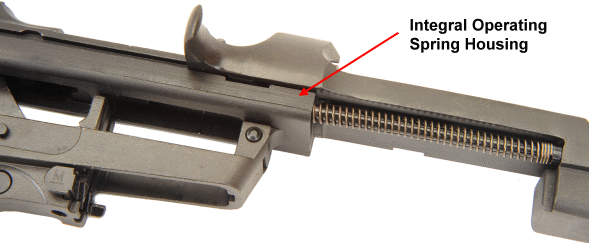
The Auto-Ordnance M1 Carbine receiver is the revised Type 3 integral operating spring housing, rather than the detachable tube type. The change made for a more rigid receiver and eliminated a source of receiver cracks. The AOC is a wide tang receiver, which is consistent with military receivers made by Saginaw and Auto-Ordnance.
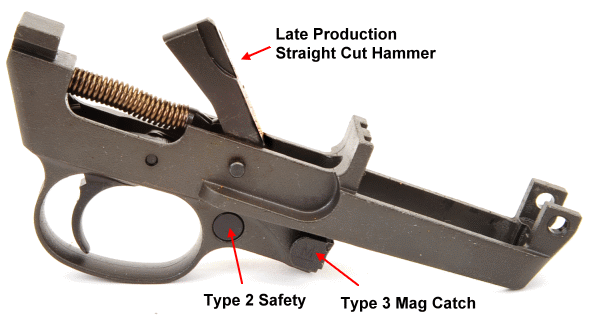
The trigger housing is neither machined from billet or constructed of stamped steel pieces as was the case with the originals, it is a casting. Where modern casting and pressure molding techniques have taken parts of this type to a very refined level, this piece is rough and shows parting lines and gate marks. Surely it is a sturdy part, much more so than an original stamped steel version, however, certainly not as nice as a machined part. The hammer is a straight cut Type 3, rather than a dog leg hammer. The change was made in the original carbine to increase striking force without increasing trigger pull. The cross bar safety is almost a Type 2, however the “U” notch is straight sided without the rise in the center.
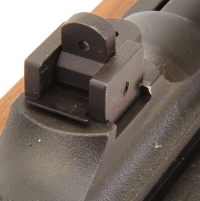 The rear sight is a non-adjustable, twin aperture flip sight, calibrated for 150 and 300 yard elevation. Canfield’s book defines the calibration as 100 and 300 yard, however, this differs from TM9-1276 War Department Technical Manual for the M1 Carbine January 1947, so I went with the manual. This type of sight was mostly replaced on latter production M1 Carbines with stamped or milled adjustable sights, however, some contractors used them for the entire duration of their production run.
The rear sight is a non-adjustable, twin aperture flip sight, calibrated for 150 and 300 yard elevation. Canfield’s book defines the calibration as 100 and 300 yard, however, this differs from TM9-1276 War Department Technical Manual for the M1 Carbine January 1947, so I went with the manual. This type of sight was mostly replaced on latter production M1 Carbines with stamped or milled adjustable sights, however, some contractors used them for the entire duration of their production run.
The sight is… unfortunate 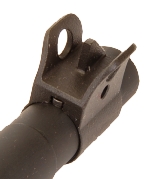 as there is potential in the combination of the 30 caliber carbine cartridge and the carbine that can’t be accessed with this type of sight. With future use in mind, I purchased a replacement sight from Brownells, # 100-004-084WB Rear Aperture Sight $25, that is electrically milled from bar stock our of 4130 steel and mimics the vintage milled adjustable sight.
as there is potential in the combination of the 30 caliber carbine cartridge and the carbine that can’t be accessed with this type of sight. With future use in mind, I purchased a replacement sight from Brownells, # 100-004-084WB Rear Aperture Sight $25, that is electrically milled from bar stock our of 4130 steel and mimics the vintage milled adjustable sight.
The front sight on the GI version is either stamped steel or milled from billet. The Model 130 front sight is another rough casting, with a flat face and pinned to the barrel. It is adequate for the M1 Carbine’s intended application.

The slide is modeled after the piece that was produced after late 1943, prior to the introduction of the M2 slide. This configuration is identified in TM9-1276 only as late production.

The Auto-Ordnance Model 130 has a flat top bolt. This configuration was used right up until the latter part of 1944 and just before the M2 was adopted. According to the folks with publishing and historian credentials (Read that as “not me”), the change to the round top bolt was considered a cost savings only, however, the same folks theorize that the round top helped M2 full auto function.
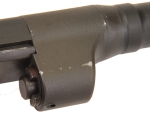
The Model 130 has a swaged in place gas cylinder, not integral, as was prevalent in military M1 production.
The chamber end of GI Carbines had a long or short skirt spacer; early long skirt, late production short skirt. I carefully inspected the chamber end of the Auto-Ordnance Model 130 barrel and no spacer was found. The receiver threads are visible all around the barrel shank.
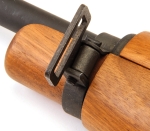
The Kahr Auto-Ordnance M1 Carbine has a Type 1 barrel band, which means thin and a bit cheesy. It is held in place by small band spring and does not seem to confidently secure the barrel and stock assembly and care must be taken when removing it or its sharp edges will scratch the barrel’s finish.
No sling and oiler is included with the Auto Ordnance carbine, however, they can be purchase as inexpensive accessories. Brownells 100-006-115WB M1 Carbine Sling & Oiler $15.
The Model 130 stock is closer to M2 than M1. It has low wood clearance around the slide with a profile that is somewhere between a flat and pot belly forearm. The oiler slot in the buttstock is oval rather than flared at either end.

Other pictures….
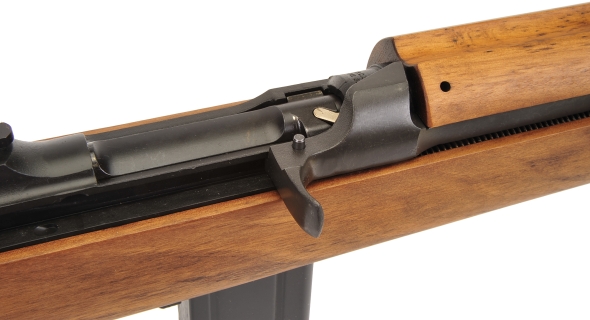
Narrow handguard sighting groove
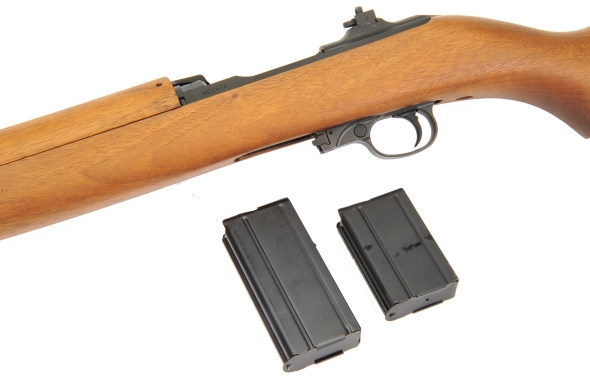
10 and 15 round magazines. The Model 130 works with GI magazines also…
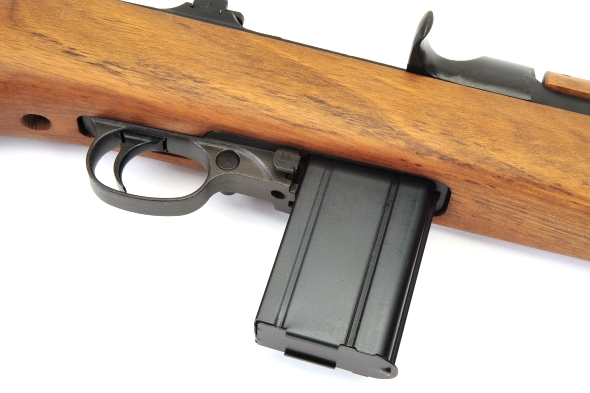
Controls are as they appear on a GI M1 Carbine. This 15 round magazine is a GI piece
The end of Part 1
So what we have here is a pretty good M1 Carbine clone that has a better than GI grade fit and finish, including a steel butt plate that is of no consequence on a rifle with little recoil. Will parts interchange with GI M1 Carbines and Vice versa? I see lots of folks suggesting they would not be a drop in fit. Welcome to the real world. Old firearms were not manufactured with computer controlled machining and assembly so they all needed a skilled person to fit replacement parts. This applied to any of the military bolt action rifles and it surely applied to the 1911 pistol of old. In fact, we’re going to go on and install parts made for the GI M1 Carbine and fit as required.
Yes, the rifle was shot before we wrapped this up. Remington 110 grain FMJ UMC ammo. A total of 3, 3 shot groups were shot at 50 yards with the flip sights in place. The best group measured 1 1/4″ and the rifle stove piped 1 out of every 5 rounds, but we are not discouraged. What can I say? We love a challenge. So we will do a little tuning and be back with Part 2.
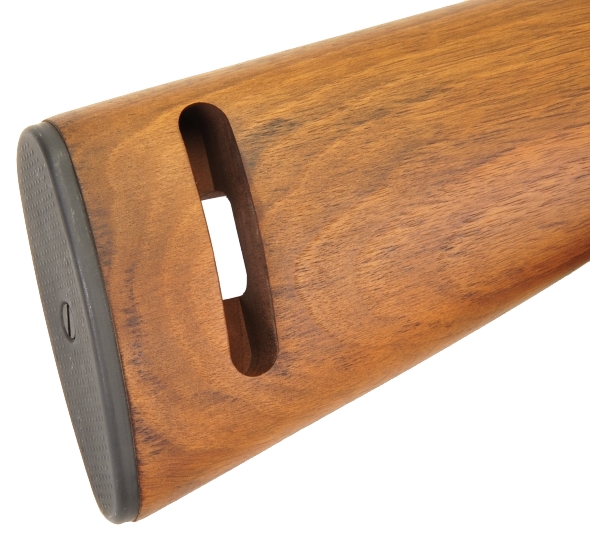

Email Notification